
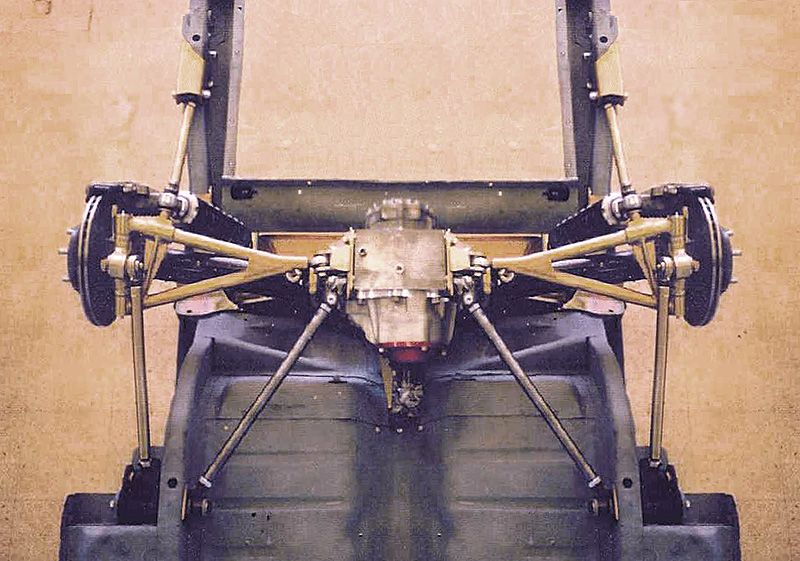
 |
 |
 |
 |
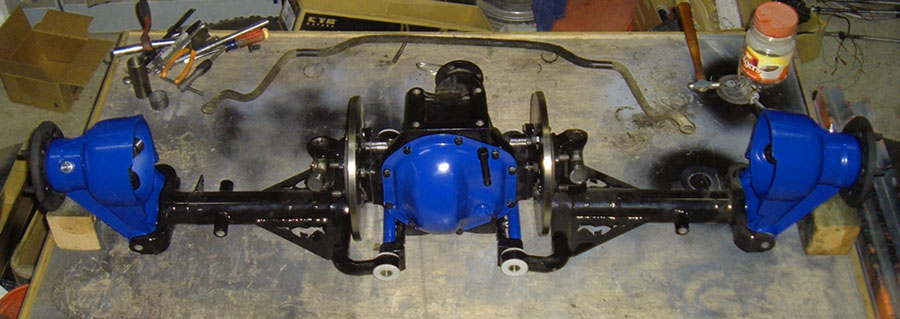 |
You are not logged in. Would you like to login?

![]() Offline
Offline
however, I can't get the output and pinion shafts to line up. stock xke pinion angle is 6 degrees up but if I mount engine at 6 degrees up to match and phase properly, the engine is way to high to fit under the hood. from what I can tell, it appears that the original engine (V12) was mounted at 0 degrees..... any suggestions on how to address this issue? I am thinking that a double carden drive shaft may be the answer.
![]() Offline
Offline

Hmmm.......... Anybody?
![]() Offline
Offline
I think the chevy likes a 4.5-5degree angle. What Im thinking is probaly not practical, but wondering if you could change out the section in the top of the framework where the pig mounts to an XJ6 that would swing the pinion down to 0 degrees and also change out the LCA brackets to match it to keep those at near flat ? Still wouldn't be parallel but the angle would be better wouldn't it ? I'm just going by pics and what I have to work with, I dont know the specs and differences between the XK's and XJs.
![]() Offline
Offline
Hey Ralphy-
hoping i can get some input on this. just so everyone knows, i have seen the post titled "Here it is!!! my much awaited solution to the pinion angle vs. suspension angle issue - Daze June 9, 2010, 11:53 am." sounds like the XJ6 side brackets might be a solution, but i really don't want to drop the rear end. also, i don't know if this will require any changes in the differential and/or cage mounts or brackets. need to break out the jag service manual and do more research. besides, jag obviously had this thing set up and working with the V12 - a much longer engine than the small block chevy that i am using. How? I'm stumped.... ![]()
![]() Offline
Offline

You don't have to drop the rear. You really need to rotate it. I think that's what Digz is saying. Also can't you drop the tail shaft at the trans a little? Then raise the motor a tad more?
The double cardan may be the best solution. I would call a drive shaft mfg. and bounce it off them. They should be knowledgeable enough. If you use a double cardan at one end doesn't the other non cardan, need to be straight? Which would mean the drive shaft would need to be a particular length. If your tail shaft were longer or shorter from factory position. You would still need to slightly change angles at either end? This would remove any vibration from the non cartan end.
Last edited by Ralphy (2/13/2012 11:55 pm)
![]() Offline
Offline
stryker,
I've just completed the same task that you are attempting at this time. The good news is that you've researched this and most importantly read the "Here it is" post from Daze. He did some good previous investigation on the whole pinion angle subject. As you know from that post, Jaguar produced three "side brackets" as you call them. They go by many other names. You say you have the XKE 6 degree version. That's the same as I initially had. TOO MUCH ANGLE! You'll never get the recomended drive line angle with the short drive shaft that you'll end up with. What you want is the 3 degree side brackets from the 1963-1968 S-Type Saloon cars. These will allow you to set your V8 at 3 degrees and end up with a good differential pinion angle line up.
I initially set myXKE side brackets aside, obtained a set of XJ6, 0 degree brackets and quickly found out they wouldn't give me the angle I wanted. Then I plug welded those holes up, redrilled them to my 3 degrees which was not easy. The machine shop work was good but not perfect. It bothered me. So I sourced a set of side brackets from a Saloon car and now I'm happy! Pinion angle up at 3 degrees, engine down at 3 degrees.
Now, you have another choice. Ignore the whole dammed pinion angle set up. I know it goes against known engineering theory but there's alot of conversions out there with a mismatched drive line angles that apparently are not causing troubles. Without rereading it, I believe that is mentioned in that post by Daze. I've read it other places on the net too. For me, I wanted it done right.
So there you have it. Take the IRS apart now and do it right or leave it as is and take your chances. That's what I've learned on the subject here on the internet.
Ken
![]() Offline
Offline
stryker,
I noticed you recieved some response over on Jag-lover's Lump forum. Good, the more opinions the better.
I thought I would add a few photos of those 3 degree side brackets.
Differential mounted on level chassis table
Close up view of 1963-1968 S-Type Saloon car side brackets
Partially assembled IRS
Resulting 3 degree climb of differential pinion
Ken
![]() Offline
Offline
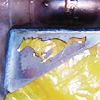
As has already been stated changing the side brackets is the way to go. it will allow you to correctly orientate the pinion and still have your LCA bracket parallel with the road. this can be problematic however with the cage. adjusting the angle of the cage as a whole will not be to bad but I am not sure how hard lining the cage up the with brackets will be after the swap. you may need to swap the cage too. In my case it want an issue because I ditched the cage.
As an aside are the two of you that removed your XKE side brackets interested in selling them?? If so I am buying
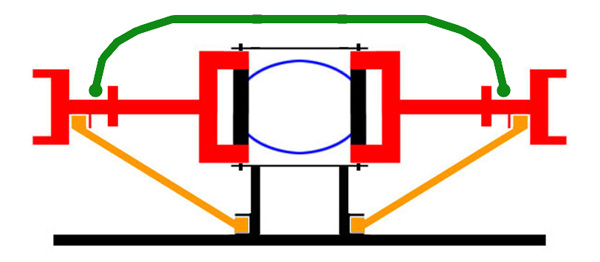
![]() Offline
Offline
Daze,
You're right there, the upper differential mount in the cage would have to be reworked. "Change one thing, you change another". Better to replace the cage and the side brackets. It's not an issue with me as I'm fabricating my own IRS mounts but I'm sure stryker will not do that.
I've studied this subject to death off and on now for over a year and as Daze has said, there's different opinions out there on what route to go but I must admit, I haven't seen one person do a Jaguar IRS installation then rip it all all apart because of a drive line issue. I'll include some links here for whoever is interested in reading more about installing the Jag IRS, mostly in Hot Rods. Some of these posts are from Australia so get used to the metric measurements.
Starting off:
The second post down has a link to:
The first post there has a link to:
The forth post on this thread again has six links to further discusion on the subject:
How did we do this before the internet?
Ken
![]() Offline
Offline
No way around dropping the cage for sure. Could you just cut the section of the cage loose that surrounds the top mount and let it swing down to position after you have put the LCA brackets on and have them bolted back into the skid plate and cage? Then add and fab to make up the gap at the edges of the top mount? I'm just trying to look at this like I didnt have another cage available to use. The vertical line of the stub axles stays the same doesn't it?
![]() Offline
Offline
"The vertical line of the stub axles stays the same doesn't it?"
Yes, that will all line up after the change of the side brackets.
"the upper differential mount in the cage would have to be reworked"
For sure, that would not be all that difficult. You're into it then though. Cleaning ,cutting, welding, the whole nine yards.


Hey, wf stryker, what do you think? This is your thread.
Ken
Last edited by 6 speed (2/16/2012 9:49 am)
![]() Offline
Offline
Sorry for the delay in getting back online. Life seems to have a way of getting in the way of my hobbies! Wow. You guys know your stuff...and thanks for the pictures - worth a thousand words as they say.
But you're right...I don't have the knowledge/experience to be removing the IRS and reconfiguring the top mounts/etc. As has been noted, Jag mounted the V12 at zero degrees notwithstanding the 6 degree slope of the pinion flange. At this point, I am inclined to follow Jag's design and mount the engine/trans with a slope that will allow me to clear the hood and see if I have any problems with driveability. If so, the engine/trans will be pretty close to where I would hope to be after doing all the work that you have described, and I can go back and drop the cage and do the work if necessary at that time.
Another alternative was suggested on my post on Jag-Lovers.org; i.e., lengthening the radius arms to rotate the differential/cage downward to align with the engine/trans. From what I have read, this may change the angle of the live axle travel resulting in a changing wheelbase length when the shocks are compressed, but that the change is negligible, especially for a "Sunday Driver" as my car will be. Again, I will try mounting the engine/trans as low as possible and see if any problems will result and then reconsider my options at that time.
Thanks for all your input. It has given me an education and a direction to follow if my "quick and dirty" approach does not work.
Stryker
![]() Offline
Offline
Seem's to me I was questioned about this topic by a member a short while ago. My response was that the LCA's on the Jag IRS are to be set level to the road surface with the Half shafts angled up to the hub for correct geometry at normal ride height. The highest I would set the static ride height would be to have the half shafts level.
The pivot angle of the LCA when viewed from the side plays no role other than to create anti-squat. It can be set level or angled up at the front for an increase in anti-squat with little effect on the negative camber gain that the basic Jaguar geometry should provide.
Nearly all the Jag IRS set ups I have seen in street rods and roadsters on line and around the Portland area were done wrong. In fact some of them were jacked up so high that the tires had positive camber at their "normal" ride height. Who ever started this notion of having the IRS all jacked up clearly did not want to build a safe cornering vehicle. They are recreating the old swing axle VW type geometry with its tenancy to axle jack then roll over when cornering . If that was the right way to set up a Jag IRS...... I would rather have a live axle.
Pinion angle should always be parallel to the engines crank center line in both the vertical and horizontal planes. The front drive shafts on some four wheel drive vehicles are the only exception I know of and they all employ double cardon joints to solve the vibration that would otherwise be created.
Last edited by tyrellracing (2/22/2012 1:39 am)
![]() Offline
Offline

Factory Jag IRS height.
![]() Offline
Offline
Looks right to me. However I dont recall the Jag having the calipers hung rearward. Has any one seen a stock Jag in this configuration or is this custom?
![]() Offline
Offline
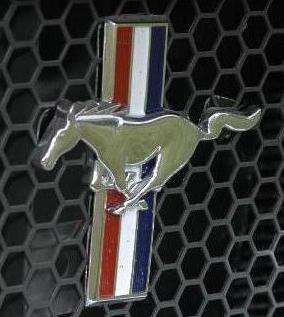
Check this out. The guys at Snow White have done Jag IRS installs in many different street rods. Check out their instructions and recommendations on pinion, LCA and half-shaft angles.
![]() Offline
Offline

Hate to open this can of worms again. But........... Snow White states : Normal Attitude For Jag 1/2 Shafts at Ride Height: 1/2 Shafts "Hang Down" Approximately 2 degrees (Outer Ends Lower Than Inner Ends)
A) Check with Magnetic Protractor. 
Last edited by Ralphy (3/12/2012 7:09 pm)
![]() Offline
Offline
There alignment and ride height seems to be motivated by their desire to tuck the diff. high in the frame while not c notching the frame for 1/2 shaft clearance and a desired rake or stance. I have seen several model A's and T's lately that were set up like this. The things look ridiculous with the LCA's at a downward angle of aprox 25 degrees from center. This set up would produce a ridiculously high roll center with highly mobile instant centers. ( Not a good thing) and would feel like an old swing axle VW when driven hard into a corner. If we can assume the shocks are near the center of travel at normal ride height then the axle jacking effect would have roughly 4 inches of increase in ride height from the jacking effect. That would have a bad affect on the C of G height Chances are good that will produce enough positive camber in the out side rear tire to make the vehicle unstable and possibly roll. IMO This is an example of how not to set up a Jag IRS.
![]() Offline
Offline

But that's not what he said, he said 2 degrees. A 12. 5 length HC would be .436 above or 7/16". If you put 4 passengers in the car it would be even less. The roll center should be higher at the rear also. Then you say this is an example how not to set up a Jag IRS. He says that's the way Jag does it.
Last edited by Ralphy (3/13/2012 3:34 am)
![]() Offline
Offline
The Half shaft and the lower control arm are not parallel. Their is roughly 15 degrees difference so if the half shaft is downward inclined at two degrees, the lower control arm will be roughly 17 degrees.Most of the vehicles he is putting these in wont hold four people. Have you seen four people ride in a T bucket or a 34 coupe. Any way, From there people raise the rears even more to give the rake desired. I have seen a half dozen roadsters in the Portland area set up like this. I have yet to see a stock Jag set up the way he described. the closest I have seen was one with the half shaft inclined up at the same angle that the LCA was angled down. Figure the roll center with the real angles not just the half shaft's 2 degree angle. Narrowed rears will increase the difference in angles between the half shaft and the LCA witch aggravates the issue even further if you maintain the 2 degree down 1/2 shaft.
Last edited by tyrellracing (3/13/2012 5:22 pm)
![]() Offline
Offline
By the way, Ralphy Have you got any further than cutting off one shock bracket on your cobra's IRS build? The Jag sites I been in state that before alignment can be done the ride height must first be set. Their definition of correct ride height was when the LCA's are parallel to the shop floor surface. I believe the link's to these sites were in the old IRS forum.
![]() Offline
Offline

OK,
Again he states factory. Factory Jags do carry four passengers. The angle in the pic looks way less than a 15 degree difference. When the rear is set, no riders are in the car. Factory suspension setups are probably a little softer than what most are doing here. So my guess is that if this were true, Jags thought would be to have the half shafts near level with riders. Now if your setup included much stiffer springs going closer to level on the HS's would be good. I don't understand why you keep referring to what others have done improperly. I think most here would agree as to what your describing is wrong. But in your direction, I see Jag units all over the place as far as angularity.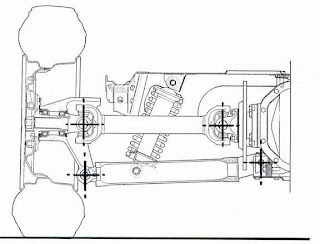
As far as my project I am on hold and I have removed more than just one shock mount. Both sides are 90 plus percent removed. I removed bump stops, cross member mounts, shock mounts and two 4" box tubes on both sides. All together, several feet of welds.
Ralphy
Last edited by Ralphy (3/13/2012 9:15 pm)
![]() Offline
Offline

This subject is widely argued on both sides. It's actually very entertaining to read, however harder to follow up. Here are several boards I found.
OZ Rodders
Jalopy Journal
Way Wrong?
Need a Churchill No. J25
Last edited by Ralphy (3/13/2012 10:04 pm)
![]() Offline
Offline

Hi Ralphy,
Isn't the picture you labeled "Factory Jag IRS height" a picture of a show truck? I know I re-opened a bag of worms but I think you and I are closer in agreement that Jag IRS half shafts should be angled slightly downward at ride height with the car at curb weight. I sure would like to see a picture of an XJ6 IRS with rear riding height set using two setting links (Churchill No. J25).
Cheers,
Doug
Last edited by irstang (3/13/2012 11:52 pm)
![]() Offline
Offline

Doug,
That pic is the only pic I have seen of that vehicle. As far as ride height, this board recognizes that pic as being right. However this seems to be a dispute between Jag IRS builders. If you read some of the links you will find some saying HS's should be pointed up, some down and some level. This argument goes on somewhat with the C3 Corvette guys also. Although a little narrower on position. Most say HS's should be level and others say pointed slightly down toward the wheel. The nearest to right speculation I think is, either the HS's should be level or the lower link should be level. This is a very narrow difference. As far as the Jag design goes, I do not know which is right. My two cents, I can't see why you would want the half shaft performing at an angle. A universal performs best being as straight as possible. My focus is on performance. The response some give to this? Is that a universal should have at least a 3 degree angle. But that is a canned answer to drive shaft universal angles, especially IRS drive shafts with fixed housings, yes? Even if you have early failure, does a builder care? Were talking about many weekend drivers here, not daily transportation.
I find this to be an interesting IRS debate.
From Denny's Driveshafts
How much driveline angle is right for my application?
Thats a loaded question. The best answer is....the least amount of driveline or u-joint angle is the best amount of angle. Try to achieve the least amount of u-joint angle but don't make it less than 1 degree. A little known fact about u-joints is that they require about 1 degree of operating angle to get the needle bearings rotating. If they do not rotate they will fail. Too much angle will also cause them to fail. The type of rear suspension also plays a big part in setting the angles as well as the engine/transmission angle. Leaf spring cars have a need for more downward pinion angle due to spring wrap-up while coil spring cars control the situation better. Hard acceleration as in the case of a drag race car requires a different setting than a street driven car. Traction bars, ladder bars, 4 links, independent rears all have special needs and requirements.
Last edited by Ralphy (3/14/2012 12:39 am)
![]() Offline
Offline

Stock 64 Jaguar E-type IRS
This car belongs to Gorm Poulsen in Denmark. It is a numbers matching car. With my High School German it looks like "renoveret IRS - den uafhængige baghjuls affjedring" means the IRS was renovated using original bearing kits.
Last edited by irstang (3/18/2012 10:32 pm)